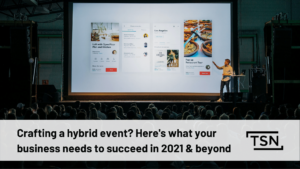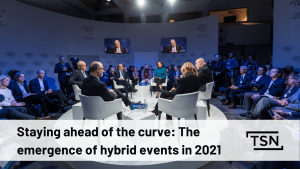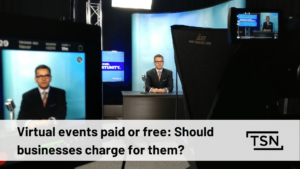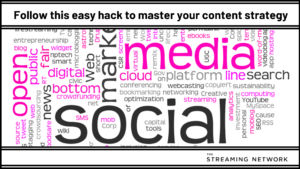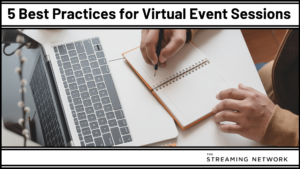No matter how many years go by, I still love getting that face-to-face interaction with our customers at The Streaming Network – I generally join my sales reps after they’ve closed the deal for the onboarding call.
What can I say? I play the role of the “old man” offering his words of wisdom very well!
Go ahead and roll your eyes – trust me, I get this a lot from my team. But, they do often placate me because I bring value to the table!
On an onboarding call last week, I was asking my standard questions about the client’s webinar program objectives such as; understanding the nature of their content and what a successful outcome would look like to them. I was taken back when I noticed that my probing was leading to silence on the other end of the phone. Finally, the client said to me, “Can you just provide me with a checklist of what not to do?”
Then it all came into place. I realized that while I was probing, upon receiving their answers, I was phrasing my follow up advice in a rather negative way:
“You don’t want to do this…” “It’s a mistake to do that…” “Whatever you do, stay away from X, Y, or Z!”
My intentions were good, but I was clearly making the client feel like they were doing everything wrong! I took a step back, apologized for my negative approach and then silently wondered how many times I had done this before. How arrogant have I been coming across? Am I being a know-it-all instead of a success partner? Worst of all, this client had a pretty awesome marketing program and was doing great things. The last thing I want is to make them feel like they’re doing everything wrong!
I realized that in making my mistake, my client had handed me the answer on a golden platter: a checklist! Something I can send the client that outlines the major “no’s” when it comes to delivering a successful webinar program.
This was a way to standardize “what not to do” so as to not make anyone feel that these tips aren’t designed to single him or her out, but are something I provide everyone.
With that in mind, allow me to present to you my “Don’t” checklist:
Don’t produce your webinars on an ad hoc basis
We’ve all seen TV shows get cancelled, that for the life of us, we can’t understand why. These are shows that the critics love and that attain a cult following, but never turn mainstream enough to accumulate mass viewership, so they get canceled.
One of the main culprits for why this happens is that in almost every case, the network changed the TV show’s timeslot mid-season. Viewers lost their ability to depend on their TV show coming on at the expected time and either started watching the new show that took over the timeslot or forgot about the show entirely. In the days before Netflix and widespread PVR, this was especially true.
Your webinar should not come across as a random one-off, but should be part of a program. If you are looking to expand your viewership and increase engagement, your viewers should be able to depend on you to deliver a certain type of content on a fairly regular basis.
This doesn’t mean you have to put out a webinar each week at the exact same time, but it does mean that you should be transparent and provide your audience with an easy-access content calendar. This will ensure they know when to tune in next.
Without this, you may encounter the same fate as the previously mentioned TV shows and lose your audience’s attention to something else. Furthermore, a content calendar keeps you disciplined to deliver the volume of webinars you set out to do that meets your objectives. Without this, it’s easy to fall behind, which leads directly to the suffering of your webinar program’s ROI. Less new lead records, less content assets, the appearance of having “nothing to say”…yeah, it’s ugly.
Be proactive and set up a content calendar!
Don’t try to do too much with your webinar
I am super guilty of this one. Being a thought leader in the webinar world, I’m often asked to deliver webinars about delivering webinars! I always have this urge to create the webinar to end all webinars…about webinars.
The problem with this “Don’t” is the concept of spreading yourself too thin by taking on too much. It’s better to take on less and do a really good job, then take on the world and accomplish next to nothing because you’re setting yourself up to fail due to unrealistic goals.
A small (but deadly) example is when you run out of time and can’t take audience questions – this directly affects their ability to engage. Audience engagement is one of the most important elements to include in your webinar program, so it’s going to be a turn-off for those who tuned in. You are also going to look unprepared if, during your opening, you declare that you look forward to taking questions and then don’t end up delivering on that.
A good starting point to ensure you don’t fall prey to this rule is: try to keep your PowerPoint deck to no more than 25 slides. We’ve found this helps our clients reduce their volume of content to a realistic amount and forces efficiency on their end.
Don’t be too “high level” with your webinar content
By delivering a webinar that barely grazes the surface of the topic at hand, you’ve let your audience down in two ways:
- You’ve underestimated their knowledge. (which comes across as underestimating their intelligence)
- You’ve failed to deliver on your promise to educate them on the topic.
While you don’t want to go to the other extreme and dive into highly technical content that only gurus of your industry would understand, don’t “dumb it down”. By following this rule, you should incent the “greener” viewers to reach out post-webinar to learn more AND you are keeping the more educated buyer’s attention – maximizing your chances of pushing them through your sales funnel and turning them into customers.
Don’t wait until the end to take questions or interact with your live audience
Only 7% of audience members will even ask a question, so you need to create trust with those who do and promote others to do the same. Make sure to tell your audience at the start of your presentation that you want to hear from them and make sure to take questions early and often throughout your presentation. This will demonstrate to other viewers the value of getting more engaged – that you are listening, value their question, and will take the time to answer them!
There are all kinds of tricks to doing this well. I would recommend you take a look at our Better Webinar Engagement E-Book.
Don’t score every viewer the same
A common lead scoring mechanism for webinars is to assign a value of 1 for registrants and 2 for viewers. This will lead you to overestimate the sales readiness of your leads and in the long run, make you wonder why your webinar leads aren’t converting.
Person A and Person B both register and view a webinar. Person A stays for 5 minutes and then leaves. Person B watches the whole webinar, submit questions, respond to polls and take other action. There are clear indicators here that Person B is a more sales ready lead than Person A. The content clearly resonated with Person B in some way that it did not with Person A.
In conclusion: Person A and B were viewers, but assigning them the same score would not make sense. Person B should most definitely rate higher on the lead score than Person A,
Don’t underestimate the value and power of your on demand webinar
I speak to people all the time who believe their webinar program does not really resonate with audiences as a recording. I don’t care who you are and what you’re talking about, you are wrong. In the era of the self-educated buyer, it is expected that they can consume your content anywhere, on any device, and, more importantly, at any time they want.
All the data from the Annual Benchmarks report is pointing to higher engagement in on-demand content, longer viewership times and the overall percentage of viewers who view on-demand content is rising drastically.
Don’t apologize for the technology (well, almost never do this)
I know this sounds contrived, since The Streaming Network provides technology, but every so often speakers and hosts will see some comments in the Chat or Q&A that someone cannot hear or see something and they will start apologizing to the ENTIRE audience for “technical issues”. I may spend all day trumpeting the benefits of the ELITE Webinar Platform over products like Cisco WebEx, Citrix Go-To Webinar and Adobe Connect Pro but I can count the number of confirmed outages on each of these products on one hand in the past 5 years. They are generally reliable and unless you know for certain there has been a global failure – the show must go on! Don’t derail your presentation and undermine the quality of your webinar by making assumptions and panicking.
Often you will find the issues were isolated to a small group of your audience, and if required, would benefit from a personal apology (to them, not the whole audience) along with a link to the recording of the webinar.
Don’t do it that way because you have always done it that way
You don’t sell the way you used to. You don’t engage on social media the way you used to. Why won’t you evolve the way your webinar runs as well? I am not sure why the industry I have devoted most of my adult life to has an obsession with doing things the same way they always have.
It looks like this: a 45 minute presentation followed by 15 minute Q&A with a survey emailed out afterwards.
People simply don’t consume content this way anymore, so you need to think differently. Mix mediums, offer different ways for your audience to connect and engage with you and look long and hard at your format.
What if you are doing all these things?
Don’t worry too much. When we first engage with customers, it is very common for us to uncover many of these issues. The fact is that webinars have been a part of the marketing landscape for over a decade, but haven’t evolved very much. Those who stop making these simple mistakes will find that their engagement increase, viewership rise and overall ROI improve.


